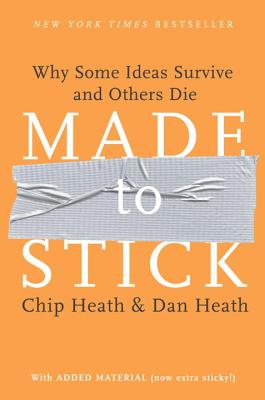Must-Read: Made To Stick
January 12, 2007
My friend Bob Sutton told me in March 2006 that I needed to watch out for the Heath brothers. Bob said they had a great book coming out and that Dan and Chip were going to be stars. I saw a galley for Made To Stick the next month and I fell in love with it.
My friend Bob Sutton told me in March 2006 that I needed to watch out for the Heath brothers. Bob said they had a great book coming out and that Dan and Chip were going to be stars.
I saw a galley for Made To Stick the next month and I fell in love with it. This book is about how ideas stick with people. Dan and Chip have studied urban myths, public health scares, parables, and political speeches to see what these ideas have in common. What they found were six concepts:
- Simplicity
- Unexpectedness
- Concreteness
- Credibility
- Emotions
- Stories
Dan and Chip say a big problem is The Curse of Knowledge - if people think they already know something, then there is no incentive to pay attention to your idea. For example, many of you think you don't need to read this book.
One answer they say is to create curiosity gaps. Their sub-title is a curiosity gap, "Why Some Ideas Survive and Others Die".
Let me give you another one - "What do Fortune 500 executives and PTA presidents have in common?" The answer is they are both selling ideas to their organizations and Made To Stick can help both improve the chances their ideas will stick. I know it isn't the strongest curiosity gap (you probably came up with many things they have in common), but the point I was trying to make is that a diverse set of people can benefit from this book.
***
At the beginning of Made To Stick, there is a story about Israeli researchers who wanted to see if there were common elements to successful advertising campaigns. They found successful ads were easily sorted and fell into one of six categories. Other ads from the same magazines where these award winners appeared could not be sorted the same way.
The researchers felt they were onto something. They took the six categories, turned them into concepts, and develop a course. The researchers wanted to see if the concepts could be taught. A random group of people were brought to the lab and split into three groups. The group were given varying levels of training and asked to produce ads for fictitious products. The group given the most training with the six concepts scored 50% better on their ads with creative directors than the other groups.
My point and the Heath brothers' point is that it is possible for a framework or recipe to improve what you do. They have got a pretty good one for making ideas stick. For all the authors, publishers, agents, publicists, and sales folks out there, this is required reading. For everyone else, Made To Stick is my first must-read for 2007.


